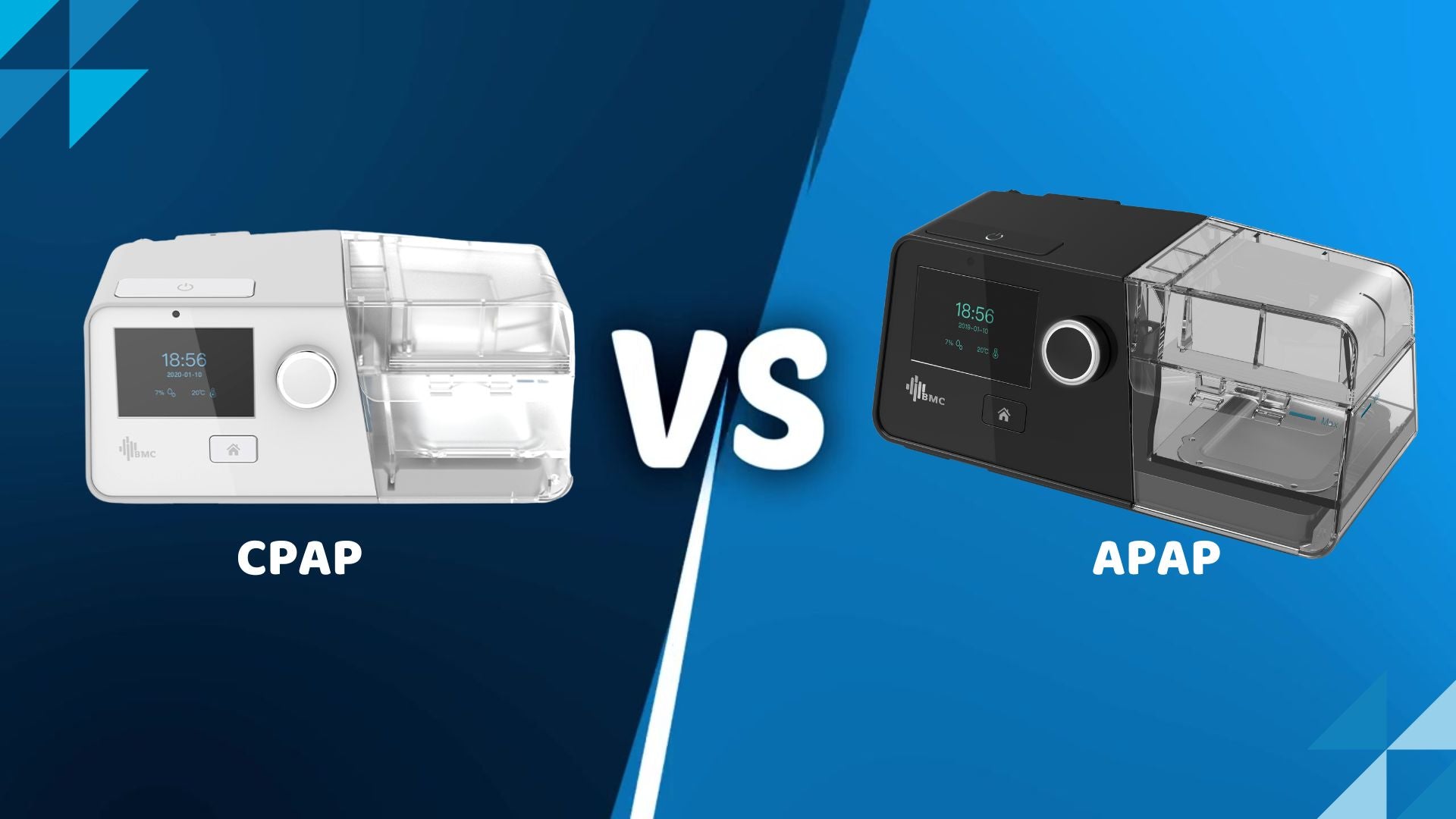If you’ve been recently diagnosed with sleep apnoea or are exploring treatment options for disrupted sleep, you’ve likely come across CPAP and APAP machines. While they sound similar, the two devices offer distinct methods of therapy, and understanding these differences can make a big impact on your comfort, therapy success, and long-term health.
In this guide, we’ll cover:
- What CPAP and APAP machines are
- How they work
- Pros and cons of each
- Who each machine is best suited for
- Tips on choosing the right machine
- FAQs from our customers
- Expert advice from the HomeMed team
Let’s dive in.
What Is a CPAP Machine?
CPAP stands for Continuous Positive Airway Pressure. It’s the most commonly prescribed treatment for obstructive sleep apnoea (OSA), a condition where the airway becomes blocked repeatedly during sleep, causing snoring, gasping, or interrupted breathing.
A CPAP machine works by delivering a continuous, fixed stream of air pressure through a mask worn over the nose or mouth. This air acts like a splint to keep your airway open and reduce apnoea events throughout the night.
Key Features:
- Fixed pressure settings prescribed by a doctor or sleep specialist
- Requires a sleep study or titration test to determine the correct pressure level
- Steady and predictable performance
- Typically more affordable than APAP machines.
Who Should Use a CPAP Machine?
A CPAP machine may be ideal for you if:
- You’ve had a sleep study and been prescribed a set pressure
- You tolerate steady airflow well
- You prefer a simpler, often more affordable device
- Your symptoms are stable and consistent each night.
Some people find the fixed pressure takes a few nights to get used to, but once adjusted, it can provide long-term, stable results.
What Is an APAP Machine?
APAP stands for Automatic Positive Airway Pressure. Unlike a CPAP machine that maintains one set level of pressure, an APAP machine automatically adjusts the pressure it delivers on a breath-by-breath basis, responding in real time to your needs.
It monitors your breathing patterns and increases or decreases pressure as needed, like when you change sleeping positions, enter different sleep stages, or experience temporary blockages in your airway.
Key Features:
- Auto-adjusting air pressure throughout the night
- No need for exact pressure calibration upfront
- More responsive to sleep position, REM cycles, and nasal congestion
- Often recommended for people who struggle with CPAP comfort.
Who Should Use an APAP Machine?
You might benefit more from an APAP machine if:
- Your breathing patterns vary throughout the night
-
You sleep in multiple positions (e.g., back, side, stomach)
- You experience allergies, congestion, or nasal blockages
- You’re highly sensitive to air pressure changes
- You’re looking for added comfort and flexibility.
APAP machines are often used in place of CPAP when users have trouble adapting to a fixed pressure setting.
CPAP vs. APAP: A Side-by-Side Comparison
|
Feature
|
CPAP
|
APAP
|
|
Pressure Type
|
Fixed pressure
|
Auto-adjusting pressure
|
|
Customisation
|
Requires manual setting via sleep study
|
Automatically adjusts to breathing needs
|
|
Cost
|
Lower cost entry-level models
|
Slightly higher cost, more advanced tech
|
|
Comfort
|
May feel too strong or too light at times
|
Smoother experience for varied sleep patterns
|
|
Best For
|
Consistent sleepers with predictable needs
|
People with variable needs, such as allergies or position changes
|
|
Ideal Use Case
|
First-time users, straightforward OSA cases
|
Sensitive sleepers, those with changing symptoms
|
Why the Difference Matters
Sleep apnoea affects more than just your sleep. Untreated, it can lead to:
- Chronic fatigue
- High blood pressure
- Heart disease
- Mood changes
- Poor concentration and memory.
Choosing the right therapy device can dramatically improve your sleep quality and reduce long-term health risks. That’s why understanding the distinction between CPAP and APAP machines is so important.
HomeMed’s Expert Tip:
Many of our customers start with a CPAP machine but later upgrade to an APAP when they want a more adaptive experience. If you’re unsure, start with a CPAP, such as the BMC G3, and if you notice discomfort or inconsistent results, an APAP might be the next step.
Final Thoughts: Which Machine Is Best for You?
There’s no one-size-fits-all answer. Both CPAP and APAP machines are effective tools in treating sleep apnoea, what matters most is your comfort, your sleep patterns, and how your body responds to therapy.
At HomeMed, we offer a carefully curated selection of CPAP and APAP machines designed for Australians managing sleep apnoea at home. Whether you’re new to therapy or upgrading your equipment, we’re here to help.
Frequently Asked Questions
Can I switch from CPAP to APAP later?
Yes! Many users start with a CPAP and upgrade to an APAP machine as they learn more about their needs. You’ll just want to check with your healthcare provider first.
Are APAP machines noisy?
No, modern APAP machines are designed to be quiet and discreet, often producing less than 30 decibels of sound (quieter than a whisper).
Do I still need a prescription for an APAP machine in Australia?
Yes, both CPAP and APAP machines generally require a prescription from your doctor or sleep specialist to ensure they’re right for your condition.
Are masks compatible between CPAP and APAP machines?
Browse our CPAP and APAP range now
Got questions? Contact our team for expert support.
Yes, most CPAP masks are interchangeable with APAP machines. HomeMed offers a wide range of universal masks for your convenience.



